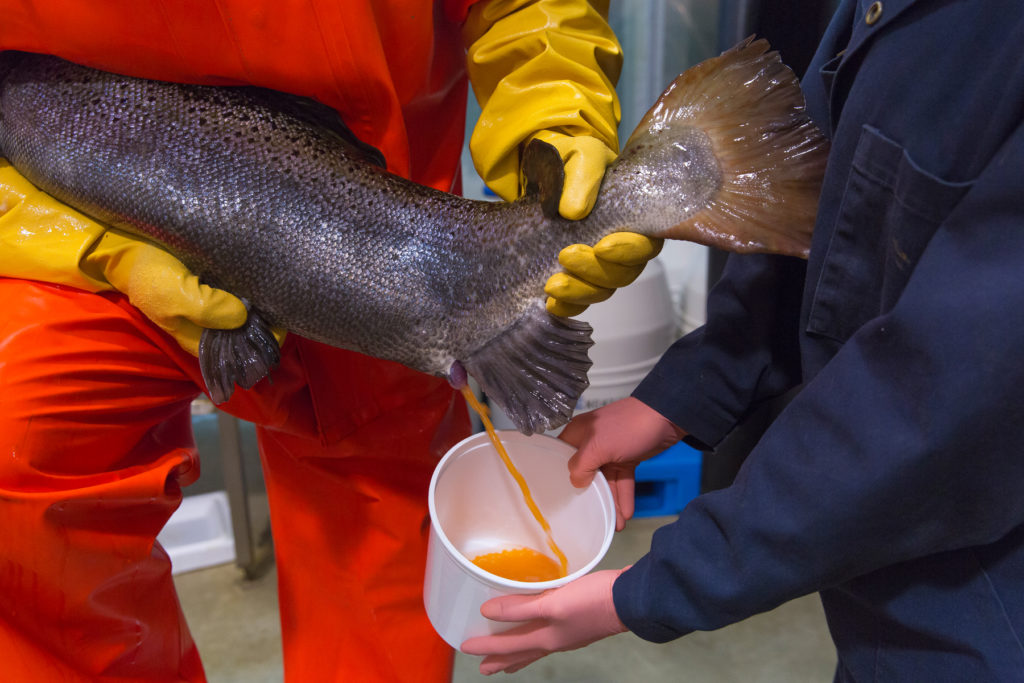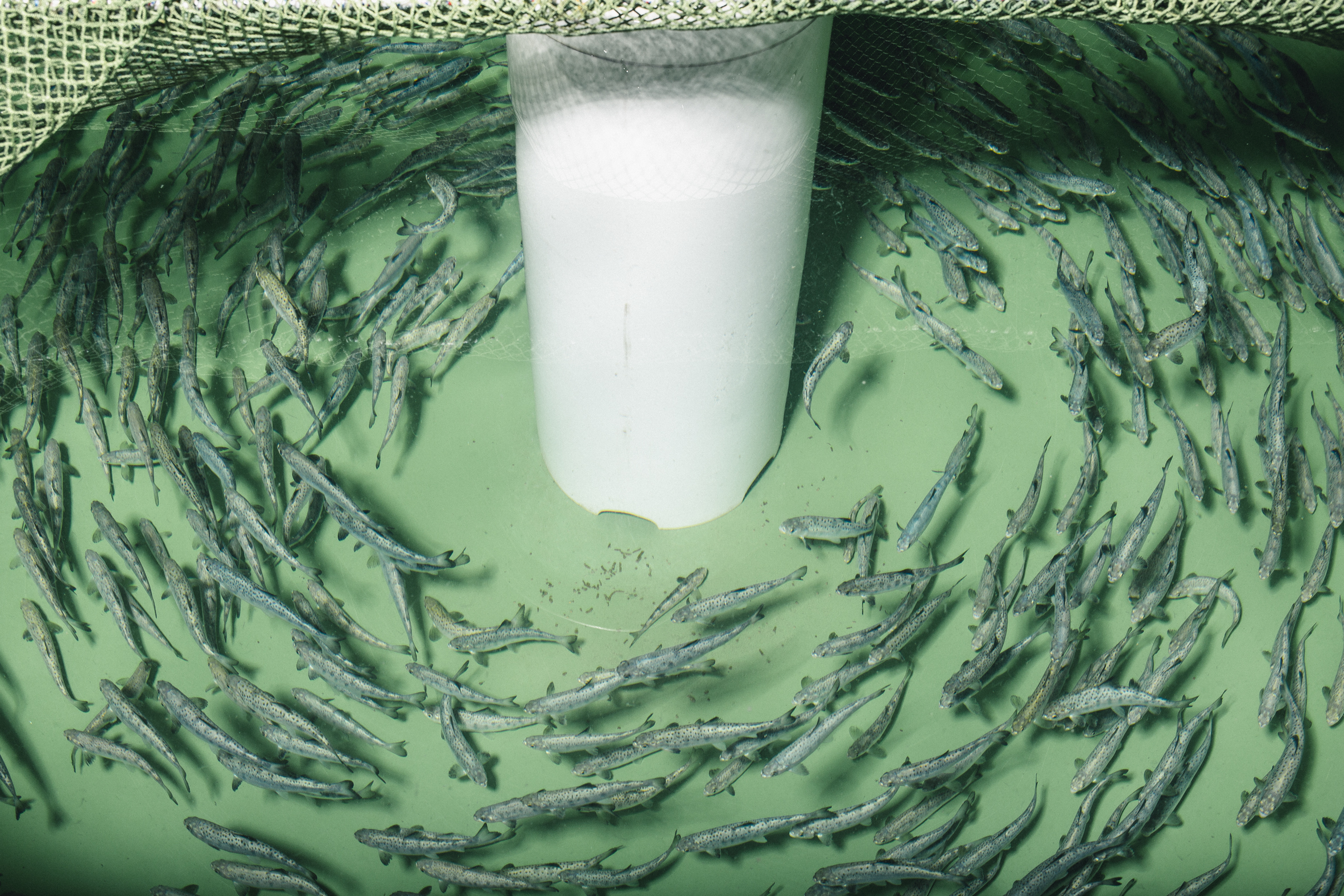A federal judge just ruled that, yes, the FDA can regulate a fish as a medicine. His written opinion is kind of a roller coaster for the mind.
Remember the GMO salmon? It was created by a company called AquaBounty back in 1989 and approved by the Food and Drug Administration in November 2015. It’s sold in Canada under the brand name AquAdvantage, and the first batch intended for the U.S. market is quietly growing in an indoor facility in Albany, Indiana. They’re expected to come to market in the U.S. sometime this year.
Or not. The fish, like most other genetically engineered plants and animals, faces adamant opposition in some quarters. Lisa Murkowski, the Republican senator from salmon country–Alaska–has slipped various riders into budget and other bills trying to throw obstacles in AquaBounty’s path. And there’s a longstanding lawsuit brought by a coalition of salmon industry folks and environmentalists that’s trying to completely overturn the approval.
The Food, Drug, and Cosmetic Act has nothing to say about genetically engineered animals. But it does give FDA the authority to regulate veterinary drugs.
That suit hit an important turning point just before Christmas, when Judge Vince Chhabria of U.S. District Court for the Northern District of California responded to requests for summary judgment in the case, threw out a bunch of claims by the plaintiffs, but let others stand, pending a separate court decision. It’s worth paying attention to, not just for the sake of knowing whether the AquAdvantage is going to find its way into your grocery store, but also because it shows how tricky it can be to get the legal system to do what you want it to.
You can read the opinion for yourself. (Chhabria is the rare judge who produces opinions you can actually read with pleasure.) But to simplify a bit, here’s how the judge responds to the plaintiffs’ main points:
Plaintiffs: FDA doesn’t have the authority to regulate GMO fish.
Fair enough. The Food, Drug, and Cosmetic Act (FDCA) has nothing to say about genetically engineered animals. But it does give FDA the authority to regulate veterinary drugs. And FDA has issued a guidance (we’ll talk about guidances a little later) that says that when you insert genetic material into an animal, that genetic material is a veterinary drug, and FDA gets to regulate it.
This idea isn’t new. Back in 2009, using the same logic, FDA approved a goat that was genetically engineered to produce anticoagulants in its milk. Several other “pharm animals” were approved over the next few years that produced useful drugs in their milk or eggs.

AquaBounty’s DNA construct isn’t essentially administered to a fish. It’s reengineering a fish that hasn’t yet begun its life
iStock/manfredxy
This is the first time the agency has used that particular pathway to approve a genetically modified animal intended to be eaten, but remember, FDA regulates lots of other sorts of drugs–antibiotics are but one huge category–that are given to animals intended for the table and which could have potential effects on the people who ultimately eat them.
I’ll confess that I find something deeply unsatisfying about FDA’s approach. We care about these fish as food, not as patients receiving treatment. And that means we should regulate them on that basis, not as some kind of workaround.
But that would require new legislation, which has problems of its own, so FDA has a long history of making do with the law that it’s got. You say you want to harvest cells from a patient’s tumor, use them to create a vaccine that stimulates immune reaction to the tumor, then inject them into the patients? Fine, FDA says. That’s a drug; we regulate it under the drug framework. How about if we want to take the patient’s own T-cells, modify them to target a cancer and inject them back into the patient? (The examples are real, by the way.) Drug. Follow the drug framework. GMO salmon? You get the idea.
FDCA says drugs are, “articles (other than food) intended to affect the structure or any function of the body of man or other animals.”
It makes sense. It keeps politics out of the decision making (for better or for worse). And it avoids the situation where FDA knows something needs to be regulated and can’t get a law passed to authorize it. And, as Chhabria points out, if the plaintiffs prevail on this point, it may well mean that no one regulates GMO salmon and that manufacturers are free to do what they want–which is exactly the opposite of what the plaintiffs want.
Plaintiffs: Yeah, but an inserted gene isn’t really a drug.
This sounds like a good argument. Drugs are things that treat diseases and relieve pain. AquaBounty’s DNA construct isn’t administered to a fish per se, and it isn’t curing anything. It’s is reengineering a fish that hasn’t yet begun its life.
But as Chhabria explains, for purposes of the law, it doesn’t matter what the dictionary thinks a drug is or what common sense thinks it ought to be. What matters is how the statute defines it, and FDCA says drugs are, among other things, “articles (other than food) intended to affect the structure or any function of the body of man or other animals.”
“’Drug’ is a defined term under the FDCA,” writes Chhabria, “and this definition is broad and dynamic by design, not by linguistic oversight. As the Supreme Court has long recognized, “the word ‘drug’ is a term of art for purposes of the Act, encompassing far more than the strict medical definition of that word.”
Plaintiffs: OK, you’ve got authority, but we can still sue you over your policy.
Here’s where things get a little weird. Let’s assume that FDA has the authority to regulate genetically engineered salmon. Under Administrative Procedures Act, people are allowed to file lawsuits over regulations.
But has the FDA actually issued regulations in regard to salmon? No, says Chhabria. It has issued guidance, and that’s different.
The FDA asserted that the old rules for veterinary drugs were still in effect, and how companies might go about filing for marketing approval.
Issuing regulations is a complicated business. There’s a lengthy, arduous procedure, with notifications of planned rulemaking in the Federal Register, formal publications and comment periods, and often hearings. But FDA didn’t issue a new rule about GM salmon. Instead, it asserted that the old rules for veterinary drugs were still in effect, and it issued a guidance explaining the agency’s current thinking on how the rules apply to genetically altered animals, and how companies might go about filing for marketing approval. It’s not a binding document. You could, for instance, come up with a different approach to filing for approval for a GM animal, and if FDA liked what you did, there’s nothing in the guidance that prevents them from accepting your application. But the guidance lets everyone know what’s likely to happen, at least for today. It’s not a rule, but for most practical purposes, it might as well be one.
FDA issues lots of guidances. They typically come out in draft form, and then are finalized based on outside input. But the process of finalizing can take years, or even decades, and sometimes it never comes. A few years back FDA withdrew close to 50 draft guidances, including a few that dated to the late 1980s, that never got finalized and had been rendered obsolete by changing technology and standards.
But here’s the thing: Under the law, while an agency can be sued over a rule, the only way it can be sued over a guidance is if the guidance has a direct and immediate effect on the complaining parties or requires immediate compliance. Since the plaintiffs in the case are mostly environmental groups and people in the salmon industry who have no intention of marketing GM salmon, the law doesn’t require them to do anything, and they face no legal penalties, so they can’t sue.
Plaintiffs: OK, but you’re still wrong.
At this point, barring appeals, the whole first part of the plaintiffs’ case has been tossed out. We’re left with the claim that really matters: that when FDA approved AquaBounty’s salmon, it did not appropriately consider potential environmental harms (for instance, the possibility that the engineered salmon would crossbreed with wild Atlantic salmon to the detriment of that species). Judge Chhabria didn’t rule on this issue (it’s going to be decided separately), but he did raise a few points:
The question is whether the agency can decline to approve a product based on environmental concerns and, if so, what standards would apply.
First, it’s not entirely clear whether FDA can decline to approve a drug based on environmental concerns. The Food Drug and Cosmetic Act instructs FDA to consider the safety of veterinary drugs, but here’s how it defines safety:
“In determining whether such drug is safe for use under the conditions prescribed, recommended, or suggested in the proposed labeling thereof, the Secretary shall consider, among other relevant factors, (A) the probable consumption of such drug and of any substance formed in or on food because of the use of such drug, (B) the cumulative effect on man or animal of such drug, taking into account any chemically or pharmacologically related substance, (C) safety factors which in the opinion of experts, qualified by scientific training and experience to evaluate the safety of such drugs, are appropriate for the use of animal experimentation data, and (D) whether the conditions of use prescribed, recommended, or suggested in the proposed labeling are reasonably certain to be followed in practice.”
So it’s clear that FDA can refuse to approve a drug that harms the animal or the people who eat the animal. (If you were wondering what they did to ensure that level of safety, here’s the agency’s explanation.) But environmental damage? Much less clear; expect to hear a lot of discussion of “among other relevant factors” as the case proceeds.
The fact is that FDA already has considered at least some environmental factors in approving the AquaBounty salmon–for example, it requires that the fish be raised in land-based facilities to make it difficult for fish to escape and mingle with wild salmon populations. (AquaBounty already has taken the step of sequestering the small cohort of male fish it needs for egg production and sterilizing its fish intended for food, which are all females.) The question is whether the agency can decline to approve a product based on environmental concerns and, if so, what standards would apply. One potential glitch as the trial moves forward: A judge could rule that FDA has no authority to make decisions based on environmental impact and no ability to impose conditions on companies whose products may be environmentally harmful but safe under the terms of the FDCA. Who would be in charge then? It’s not clear, but the answer might be “nobody.”
But that’s another day’s concern. For the moment, barring the possibility that a higher court reverses Chhabria, FDA has the right to regulate genetically altered animals under its pathway for veterinary drugs, the rest of the suit will continue, and a batch of AquAdvantage salmon continue to fatten up down in Indiana.
They may have thought that being raised in a tank meant they didn’t have to swim upstream against raging currents. They were wrong.










